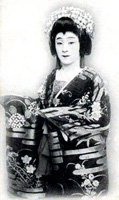but it is the actor rather than the play itself that is "the absolute focus"2
of the performance and the audience's attention.
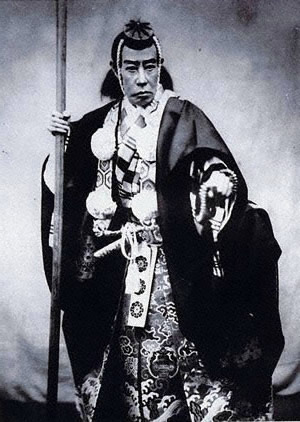
1 “Actor, Role, and Character: Their Multiple Interrelationships in Kabuki” by Barbara E. Thornbury appearing in A Kabuki Reader: History and Performance, Samuel L. Leiter, ed., M.E. Sharpe, 2002, p. 236.
2 “Kabuki: Signs, Symbols, and the Hieroglyphic Actor” by Leonard C. Pronko appearing in A Kabuki Reader: History and Performance, Samuel L. Leiter, ed., M.E. Sharpe, 2002. p. 241.
A Tough Act
Source: The Kabuki Theatre of Japan, A.O. Scott, George Allen & Unwin Ltd., 1955, p. 157.The kabuki theater "forces the most rigid discipline upon the actor who will face hard work, hard criticism and hard living in the pursuit of his career." The aspiring actor must undergo long years of training and, to succeed, will have "to recreate a stage character in a traditional form, but yet have a subtle enough personality to give it life and spirit and not make it mere flat repetition." If "he attains a mastery of his craft and is accepted by the hierarchy of the profession he must then stand trial before his audience in a way that no other actors do…"
The profession of the kabuki actor is hereditary and, with very few exceptions, kabuki players are connected by blood ties to the theater in some form or another. Most actors are descended either directly or by marriage from acting families with long lineages.
A Tough Audience
"Going to the theatre was [like] going to a ball game except that one rooted for an actor rather than an athlete or team."1 The kabuki audience "knew the rules thoroughly" and focused on the technique of the actor and his interpretation and then applied "a mental criticism to his performance in the light of the masters who have held the name before him."21 The Kabuki Theatre of Japan, A.O. Scott, George Allen & Unwin Ltd., 1955, p. 157.
2 A Kabuki Reader: History and Performance, Samuel L. Leiter, ed., M.E. Sharpe, 2002, p. xxiii
The Naming Convention
The Kabuki Theatre of Japan, A.O. Scott, George Allen & Unwin Ltd., 1955, p. 157, 159."Once an actor has achieved professional standing he is known to the public by a stage name in itself hereditary, which has been passed on from generation to generation, and it is this which condemns him to a test peculiar in its severity before he can hope to attain a minimum of appreciation."
"An actor’s name...consist[s] of three parts, for example Nakamura Utaemon VI. The first name is the theatrical family to which the actor belongs and to which he generally owes his training and professional debut, although sometimes an actor has been adopted into another theatrical family, whose name he assumes, later in his career. The second name, Utaemon, indicates personal status as an actor. Such a title can only be assumed after the death of a previous holder, under a succession system which jealously guards the reputation of actors’ titles. The Roman numeral at the end of the name shows the generation so that the present Nakamura Utaemon is the sixth actor to bear the title since it was initiated."
The Actors in the Collection's Kabuki Theater and Portrait Prints
Arashi Kangorō 嵐冠五郎 (active c. 1863)
A koshibai actor, who was born in 1903 and died in October 1930, held the name of Azuma Tōzō.
Bandō Hikosaburō V 坂東 彦三郎 (1832 ~ 13 October 1877)
Sources: Kabuki 21 website http://www.kabuki21.com/hikosaburo5.php and Global Performing Arts Database http://www.glopad.org/pi/en/record/person/1002011
Stage names: Bandō Hikosaburō V, Bandō Takesaburō I, Bandō Tsurunosuke I
Other name: Bandō Shinsui V
Nickname: Meijin Hikosaburō(Hikosaburō the expert)
Hikosaburō V came from a family of carpenters living in the Asakusa area of Edo. He was adopted by the actor Bandō Hikosaburō IV (1800-1873) in 1840 and took the name Bandō Tsurunosuke.He first appeared on stage at Nakamura-za Theatre in November 1842. He changed his name into Bandō Takesaburō at Kawarazaki-za Theatre in January 1846. Then he took the name Bandō Hikosaburō V at Ichimura-za Theatre in March 1856.
Bandō Hikosaburō V was an outstanding actor, able to play tachiyaku, onnagata or katakiyaku roles, in both jidaimono and sewamono. His forte were the great Gidayū Kyōgen roles. He was a star of the first half of the Meiji era and had a strong artistic influence on Onoe Kikugorō V, the future star of the second half of the Meiji era. He unfortunately died too early, at the age of 45.
His rivalry with Nakamura Shikan IV was one of the hottest in Kabuki history: "So nearly matched in ability were Shikan and Hikosaburō, with but two years' difference in their ages, that they were pitted against each other, and their patrons often indulged in fights over them. During a performance, when these actors were playing together, they came through the audience by way of the two hanamichi, the one to the right of the stage a mere footpath, that to the left a platform that was in reality a continuation of the stage proper. They quarreled as to who should take the main hanamichi, and the dispute waxed so hot that they finally drew lots to settle the matter." (Zoë Kincaid in "Kabuki, the Popular Stage of Japan")
Bandō Kakitsu I 坂東家橘 (ばんどう かきつ)(1847–March 18, 1893)Stage names: Bandō Kakitsu I, Ichimura Kakitsu V, Ichimura Uzaemon XIV, Ichimura Takematsu III
Bandō Kakitsu I was a Meiji tachiyaku, who excelled in wagotoshi roles. He was also the last zamoto of the Ichimuraza.
Bandō Kamezō I 坂東 亀蔵 (1800-1873)
Source: Kabuki 21 website http://www.kabuki21.com/kamezo1.php
Stage names: Bandō Kamezō I, Bandō Hikosaburō IV, Ichimura Kamesaburō, Ichimura Takesaburō
Other name: Bandō Shinsui IV
The actor Bandō Kamezō I's haimyō was Shinsui and, although he never officially held the name of Bandō Shinsui IV, he was considered as the fourth actor of this line.
Bandō Kamezō I was a talented and popular tachiyaku, an outstanding dancer, who excelled in nimaime (at the beginning of his career), budōgoto and jitsugotoshi roles, then in jitsuaku and oyajigata roles in his latter years.
Bandō Kichiya I 坂東吉弥 ( (1846 ~ 11 September 1873)) (See Bandō Mitsugorō VI)
The actor Bandô Mitsugorô VI held the name of Bandô Kichiya I from the 5th lunar month of 1850 to the 4th lunar month of 1856.
Bandō Mitsugorō IV 坂東 三津五郎 (1802-1863)
Source: Kabuki 21 website http://www.kabuki21.com/mitsugoro.php
Stage names: Morita Kan'ya XI, Bandō Mitsugorō IV, Bandō Minosuke II
Other name: Morita Zekō
The actor Morita Kan'ya XI (1802-1863) held the name of Bandō Mitsugorō IV from March 1832 to October 1850.
Morita Kan'ya XI was both a tachiyaku (actor specialized in male roles) and the zamoto (kabuki performance promoter) of the Moritaza (from 1856 to 1863). He was tall, handsome and, as an actor, excelled in sewamono (domestic dramas dealing with the lives of commoners). He was also a talented jitsuaku (evil villian) and an outstanding dancer.
In his Mitsugorō years, he was both a stage partner and a rival (for the title of Edo's best tachiyaku) of Nakamura Shikan II, imitating the glorious rivalry of Bandô Mitsugorô III and Nakamura Utaemon III.
Source: Kabuki 21 website http://www.kabuki21.com/mitsugoro6.php
Stage names: Bandō Mitsugorō VI, Bandō Kichiya I
Nicknames: Aba Mitsu ("pockmarked Mitsu"); Kichiya Mitsugorô
Connections: Father: Bandō Shûka I; Adopted son: Bandô Shûka II
In the 2nd lunar month of 1851 he plays the role of the kamuro (young girl attendant for high-ranking courtesan) Katsumi in the premiere at the Ichimuraza of Sakurada Jisuke III's Kiyomoto-based dance "Akegarasu Hana no Nureginu", commonly called "Urazato Tokijirō".
3rd lunar month of 1855: his father Bandō Shūka I dies.
Bandō Mitsugorō VI was in fact Bandō Mitsugorō V during his career but the Kabuki world decided to give posthumously this prestigious name to his father, who became the fifth of the line and his son the sixth.
The actor Bandō Kamezō I's haimyō was Shinsui and, although he never officially held the name of Bandō Shinsui IV, he was considered as the fourth actor of this line.
Bandō Shūchō II 坂東秀調 (1848-1901)
Source: Kabuki 21 website http://www.kabuki21.com/shucho2.php
The actor Bandō Shūchō II held this name from February 1884 to September 1901.
Stage names: Bandō Shūchō II, Bandō Shūchō, Ichikawa Yonejūrō III, Ichikawa Yonemaru
Other name: Yoshimatsu
Real name: Mizuta Yoshijirō
Nickname: Sakasa Hyōtan ("the upside-down gourd")
Bandō Shūchō II was not a good-looking actor and his diction was not great but he nevertheless succeeded in making a great career as an onnagata. He excelled in the roles of sewamono house wives. His stage partners were the best Meiji tachiyaku like Ichikawa Danjūrō IX, Onoe Kikugorō V or Ichikawa Sadanji I.
Bandō Shūka I (初代)坂東しうか (1813 ~ 6 March 1855)Source: Kabuki 21 website http://kabuki21.com/shuka1.php
Stage names: Bandō Shūka I, Bandō Tamasaburō I
Others names: Bandō Mitsugorō V, Bandō Tamanosuke
Connections: Adoptive father: Bandō Mitsugorō III , Son: Bandō Mitsugorō VI , Adopted son: Bandō Minosuke IV , Disciples: Bandō Kashiku, Bandō Matahachi (?)
He is adopted by Bandō Mitsugorō III and given the name Bandō Tamanosuke. In November 1824, he appears on stage for the first time, taking the name of Bandō Tamasaburō I at the Ichimuraza. In November 1839, he takes the name of Bandō Shūka I at the Ichimuraza. He was posthumously given the name Bandō Mitsugorō V
Bandō Shūka I was an outstanding onnagata, who developed excellent diction and personal acting techniques. His forte were courageous and wild-spirited female roles. His fame in Edo between 1840 and 1854 was as high as his tachiyaku stage partner Ichikawa Danjūrō VIII.
Bandō Shūka I's best roles: Okaru ("Kanadehon Chūshingura"), Yae ("Sugawara Denju Tenarai Kagami"), Agemaki ("Sukeroku"), Shizuka Gozen ("Yoshitsune Sembon Zakura"), Onna Narukami, Ohan ("Katsuragawa Renri no Shigarami").
Bandō Shūka II 坂東 しうか (? - 1891)
Source: Kabuki 21 website http://www.kabuki21.com/shuka.php
Born in Kamigata at an unknown date. He was the second son of Nakamura Karoku I and he started his career in 1851, performing under the name of Nakamura Tanetarō I. He took the name of Nakamura Moshio II in 1865. He went to Edo in 1873 and took the name of Nakamura Karoku II in March. A few months later, he was adopted by Bandō Mitsugorō VI, who helped him taking the name of Bandō Shūka II in May 1874. A few years later, he left the Bandō clan and went back to Kamigata. He worked hard as an onnagata actor but his popularity did not really grow. He died in Osaka the 5th May 1891.
Bandō Takesaburō I 坂東 竹三郎 (1832~ 13 October 1877) (See Bandō Hikosaburō V)
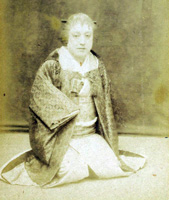 | Born in Osaka. Brother of Ichikawa Sadanji I. Real name is Arajirō akamura. His portly physique lent itself to playing sumo wrestlers. Understudy to Onoe Kikugorō V. (Photo from The British Museum Album of 42 carte-de-visite photographs of kabuki actors. Original monochrome albumen prints, mounted in a folding album.) |
Source: Kabuki 21 website http://www.kabuki21.com/danjuro8.php
Stage names: Ichikawa Danjūrō VIII, Ichikawa Ebizō VI, Ichikawa Shinnosuke II
Other name: Ichikawa Hakuen (III)
Connection: Great-great-great-great-grandfather: Ichikawa Danjūrō I, Great-great-great-grandfather: Ichikawa Ebizô II (Danjūrō II), Great-great-grandfather: Ichikawa Ebizō III (Danjūrō IV), Great-Grandfather: Ichikawa Hakuen I (Danjūrō V)
Father: Ichikawa Danjūrō VII
Brothers: Ichikawa Danjūrō IX, Ichikawa Ebizō VII, Ichikawa Ebizō VIII, Ichikawa Komazō VI, Ichikawa Enzō I, Ichikawa Kūzō
"Like his father, Ichikawa Danjūrō VIII excelled in the aragoto ('rough-stuff') roles for which the Ichikawa lineage was famous. But as well as audacious young heroes, he was also extremely successful in the various roles of young lover (nimaime). Together with his good looks, this made him especially popular with female fans. When he played Sukeroku, in which he had to immerse himself in a barrel of water, the water was subsequently sold at exorbitant cost to avid admirers. Even when he had to appear as Yosaburō with a scarred face, pastry shops sold beanpaste buns with cracked outer skins called 'Yosaburō buns, which were devoured by the actor's fans. Despite his success, or even because of it, he was plagued by personal problems, perhaps exacerbated by his early achievements and the jealousy this caused among older actors. In 1854 [August 8], during a tour of performances in Osaka with his father, he was found in his inn with his wrists slashed. He was suffering from massive debts, caused by his lifestyle, which emulated the excesses of his father." (from the The Fitzwilliam Museum Website).
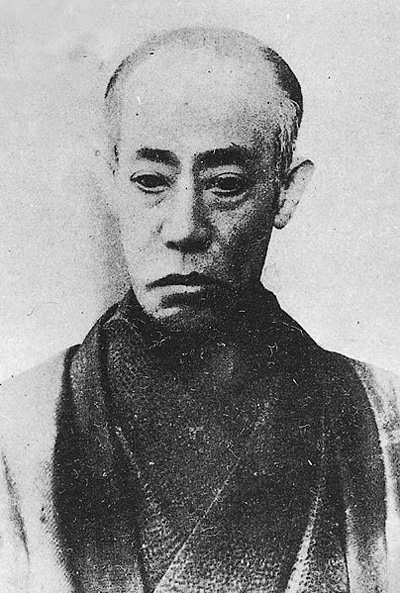 | Ichikawa Danjūrō IX 市川 団十郎 (1838 ~ 13 September 1903) Source: Kabuki 21 website http://www.kabuki21.com/danjuro9.php Stage names: Ichikawa Danjūrō IX, Kawarazaki Sanshō, Kawarazaki Gonnosuke VII, Kawarazaki Gonjūrō I, Kawarazaki Chôjūrō III Other name: Ichikawa Jukai II Ichikawa Danjūrō IX belonged to the triumvirate of stars who dominated the Kabuki world during the Meiji era. (The two others were Onoe Kikugorō V and Ichikawa Sadanji I.) He spent lots of time and energy pioneering a new genre called katsureki but the Tōkyō audience was more receptive to his amazing performances in the great roles of Kabuki like Ōboshi Yuranosuke ("Kanadehon Chūshingura"), Kumagai Jirō Naozane ("Kumagai Jin'ya"), Sukeroku ("Sukeroku Yukari no Edo Zakura") or Benkei ("Kanjinchō"). |
Ichikawa Danshirō III 市川 段四郎 or 市川 團四郎 or 市川 団四郎 (October 5, 1908 – November 18, 1963)
Source: Kabuki 21 website http://www.kabuki21.com/danshiro3.php
Real name: Kinoshi Masanori
The actor Ichikawa Danshirō III held this name from July 1930 to November 1963. Ichikawa Danshirō III was a tachiyaku actor, who did not reach the levels of fame of his father Ichikawa En'ō or his elder son Ichikawa Ennosuke III but was a steady mainstay of the Omodakaya guild. His best roles were Tarōgo ("Kurozuka"), Hayami no Tōta ("Yoshinoyama") and Iwanaga Saemon ("Akoya").
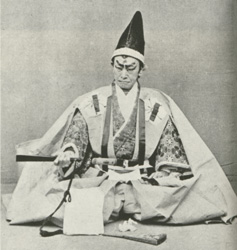 Source: Kabuki - The Popular Theater, Yasuji Toita, Walker/Weatherill, 1970, pl. 122. | Ichikawa Danzō VII 市川 團蔵 (20 March 1836 - 11 September 1911) Source: Kabuki 21 website http://www.kabuki21.com/danzo7.php Stage names: Ichikawa Danzō VII, Ichikawa Kuzō III, Ichikawa Hakuzō II, Ichikawa Momotarō II,Ichikawa Ginō I Born in Edo in 1836, his father Maruya Isaburō manages a restaurant in the district of Ashi-chō. In 1838 he is adopted by Ichikawa Kuzō II, who gives him the name of Ichikawa Ginzō I. In the 11th lunar month of 1840, Ichikawa Ginzō I takes the name of Ichikawa Momotarō II until the 11th lunar month of 1847 when he takes the name of Ichikawa Hakuzō II. In 1854, Ichikawa Hakuzō II takes the name of Ichikawa Kuzō III. In 1888 he quarrels with Ichikawa Danjūrō IX and they are not reconciled until 1895. In June 1897, Ichikawa Kuzō III takes the name of Ichikawa Danzō VII at the Meijiza.In September 1911, Danzō falls seriously ill and dies. |
Ichikawa Ebijūrō V 市川鰕十郎 (?-1885)
Date of birth not clarified. He started his career as a disciple of Nakamura Utaemon IV, who gave him the name of Nakamura Komasaburō. He made his training in miyaji shibai and hama shibai. He was adopted by Ichikawa Kodanji IV and received the name of Ichikawa Yonejūrō II. He quarreled with his adoptive father at the beginning of the Keiō era and had to leave the Ichikawa clan. He took the name of Nakamura Baijaku in 1866. He went to Kamigata in 1868 and received the patronage of Onoe Tamizō II, who gave him the permission to take the name of Ichikawa Ebijūrō V. He held this name up to his death in June 1885. He was a supporting katakiyaku actor.
Ichikawa Ebizō V 市川海老蔵 (1791-1859)
Source: wikipedia Japan http://ja.wikipedia.org/wiki/%E5%B8%82%E5%B7%9D%E7%AD%B5%E5%A5%B3
明治5年 (1872) 十代目片岡仁左衛門に入り片岡久我松。のち三代目澤村田之助門下で澤村小田之。のち養子となり沢村曙山。養父の死後は二代目市川左團次門人となり市川延女と名乗る。九代目市川團十郎の一座で専ら腰元を演じたり、小芝居の宮戸座に出演したりしていた。のち関西に移籍し初代中村鴈治郎一座で老女形として活躍。
『仮名手本忠臣蔵・六段目』のおかや、『双蝶々曲輪日記・引窓』のお幸などを得意とした。また昭和10年 (1935) 10月の明治座、『競伊勢物語』で初代中村吉右衛門の紀有常に相方で小よしを演じて評判を呼んだ。品格に欠けるが老巧な芸であった。
Ichikawa Ennosuke II 市川 猿之助 (21 May 1888 ~ 12 June 1963)Source: Kabuki 21 website http://www.kabuki21.com/eno1.php and The Kabuki Theatre of Japan by A. C. Scott, George Allen and Unwin Ltd, 1955 p. 184-185.
Stage names: Ichikawa En'ō, Ichikawa Ennosuke II, Ichikawa Danko I
Real name: Kinoshi Masayasu
The first son of Ichikawa Danshirō II, he made his first stage appearance in 1892 as Ichikawa Danshi. In 1910 he succeeded to the title Ennosuke. During the Taisho era (1912-26), he was known as a progressive actor and traveled in Europe studying Western drama. He has performed in many new dance plays and the more modern type of Kabuki dramas. His real forte lies in comedy. In the traditional sense he is not a true Kabuki actor at all, although today he appears in most of the important classical plays. A small, stocky man, he possesses tremendous vigour for his age and leads his own troupe.
Ichikawa Gonjūrō 市川権十郎 (September 15, 1848 – March 27, 1904)
Stage names: Ichikawa Gonjūrō, Arashi Rikaku, Arashi Rikaku III, Arashi Yoshisaburō, Arashi Kichimatsu,Arashi Kichimaru
Real name: Okada Kikusaburō
Ichikawa Gonjūrō was a tachiyaku actor, born and trained in Kamigata, who became one of the best disciples of Ichikawa Danjūrō IX. His most striking features were great vocal projection, great lines delivery and ... a terrible Kamigata accent. He was also involved in a criminal case, called "Yoarashi Okinu Satsujin" (the murder of Okinu during a night storm - It sounds like a Kabuki drama), which led him to the Tōkyō jails, where he spent three years. (See the print The True Story of Harada Okinu in this collection for more information on the criminal case.) His others notable performances include the roles of Mizuno Jūrōzaemon (Yudono no Chōbei) and Lord Ii Kamon-no-Kami Naotaka (Ōsakazuki Shusen no Tsuwamono).
Ichikawa Ichizō III 市川 市蔵 (1833 ~ 2 March 1865)
Source: Kabuki 21 website http://www.kabuki21.com/ichizo3.php
Stage names: Ichikawa Ichizō III, Onoe Ichizō
Other name: Ichikawa Chōshō
Ichikawa Ichizō III was a promising 19th century tachiyaku actor. This tall actor was able to perform a wide range of roles, not only as a tachiyaku, but also as a katakiyaku or an onnagata. His field of excellence was jitsugoto. He unfortunately died too young, at the beginning of his 30s; if he had lived longer, he most likely would have taken the name of Ichikawa Ebijûrô, to honor the memory of his grandfather.
Ichikawa Kodanji V (五代目)市川小団次 (18 August 1850 ~ 6 May 1922)Source: Kabuki 21 website http://www.kabuki21.com/kodanji5.php
Stage names: Ichikawa Kodanji V, Ichikawa Nedanji I
Real name: Suwara Kiyosuke
Ichikawa Kodanji V was a Meiji/Taishō actor, able to play both tachiyaku and onnagata roles. His forte were jitsugotoshi roles. Less brilliant than his amazing father Ichikawa Kodanji IV, he focused on classic dramas and was not involved in any of the reformist experiments which shook the Kabuki world.
Source: Kabuki 21 website http://www.kabuki21.com/danzo7.php
Ichikawa Danzō VII held the name Ichikawa Kuzō III from 1854 to June 1897.
Ichikawa Monnosuke V 市川 門之助 (1821 ~ 12 September 1878)
Source: Kabuki 21 website http://www.kabuki21.com/monnosuke5.php
Stage names: Ichikawa Monnosuke V, Inchikawa Shinsha I, Matsumoto Shichizō III, Iwai Kumetarō, Segawa Michitarō
He starts his career as a disciple of the actor Segawa Kikunojō V, who gives him the name of Segawa Michitarō. Later on, he joins the Iwai clan, becoming a disciple of Iwai Hanshirō V and performing under the name of Iwai Kumetarō. Following his master in a Kamigata tour, he meets the young actor Matsumoto Kōshirō VI, who welcomes him as a disciple and gives him the name of Matsumoto Shichizō III.
1st lunar month of 1845: Matsumoto Shichizō III becomes disciple of Ichikawa Ebizō V and takes the name of Ichikawa Shinsha I. 2nd lunar month of 1870: Ichikawa Shinsha I takes the name of Ichikawa Monnosuke V.
August ~ September 1878: he works with his son Ichikawa Benzō for the reopening of the Ichimuraza but he suddenly falls ill and dies.
Ichikawa Monnosuke V was a talented supporting actor, who played a major role in the transmission of the art and kata of the Bunka/Bunsei era to the Meiji rising stars. He was trained as a onnagata in the two most important Edo onnagata clans (Segawa and Iwai), and had the chance to share many stages in Kamigata with the actor Nakamura Tomijūrō II. He was specialized in spouse or fukeoyama roles, in sewamono or jidaimono dramas. In his latter years, he also performed tachiyaku roles. He was highly praised by the star Ichikawa Danjūrō IX.
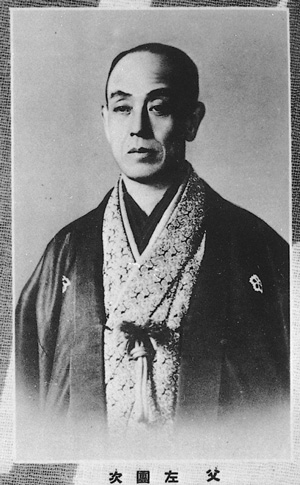 National Diet Library, Japan | Ichikawa Sadanji I市川 左団次* (28 October 1842 ~ 7 August 1904) * also written as 左團治 Source: Kabuki 21 website http://www.kabuki21.com/sadanji1.php Stage names: Ichikawa Sadanji I, Ichikawa Masuwaka, Ichikawa Koyone I, Ichikawa Tatsuzō Ichikawa Sadanji I belonged to the triumvirate of stars who dominated the Kabuki world during the Meiji era (the two others were Ichikawa Danjūrō IX and Onoe Kikugorō V). He was the leading actor of many shinkabuki dramas and worked on scripts written by authors who did not belong to the Kabuki world, like Matsui Shôô, or adapted contemporary popular novels, like Kōda Rohan's "Hige Otoko". His two most successful roles were Marubashi Chūya and Baba Saburobei in "Keian Taiheiki" and "Ôsakazuki". |
"At first he was a poor actor, and gave no sign of a promising career. Mokuami, the playwright, assisted him greatly by providing him with new plays and furnishing him with advice, and so great was his advancement that he was able to hold his own with Danjūrō and Kikugorō" (Zoë Kincaid in Kabuki, the Popular Stage of Japan).
In 1893, he established the Meijiza (Meiji theater), serving as its Zato (head).
Ichikawa Sadanji II 市川 左団次* (19 October 1880 ~ 23 February 1940)
* also written as 左團治
Source: Kabuki 21 website https://www.kabuki21.com/sadanji2.php
Stage names: Ichikawa Sadanji II, Ichikawa Enshō II, Ichikawa Koyone I, Ichikawa Botan
Real name: Ichikawa Enjirō
Ichikawa Sadanji II, whose father was Sadanji I, made his first stage appearance at the age of 3 1/2 under the name Ichikawa Botan. In September 1906, two years after his father's death, he took the name Sadanji II. He spent 9 months in Europe from December 1907 until August 1907 studying theater and dance, returning to the Japan through the United States. In 1928 he organized the first foreign tour of a Kabuki troupe, performing in Moscow and Leningrad. He past away on February 23, 1940.
"Ichikawa Sadanji II was one of the most popular actors in Japan in the first half of the twentieth century. He was an open-minded reformist, working hard to promote new plays, and an adept of revivals of long-forgotten classical dramas"
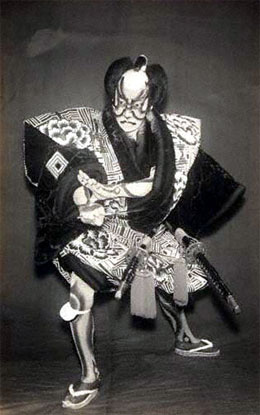 Ichikawa Sanshô V playing the role of Arajishi Otokonosuke in the drama "Meiboku Sendai Hagi", which was staged in January 1936 at the Kabukiza | Ichikawa Sanshō V 市川三升 (1882-1956) Stage names: Ichikawa Sanshō V, Horikoshi Fukusaburō Other name: Ichikawa Danjūrō X (posthumously) Real name: Horikoshi Fukusaburō Ichikawa Sanshō V*, is arguably the most important actor in the rough aragoto tradition. Sanshō was an unusual figure in modern kabuki, adopted from a non-acting family when he married the daughter of Ichikawa Danjūrō IX (1838 – 1903), inheritor of the most important lineage of kabuki actors. On the death of his father-in-law, Sanshō began to appear onstage, though he never took the Danjūrō stage name.He died the 1st of February 1956. He posthumously received the name of Ichikawa Danjūrō X in 1962. * the text in Dramatic Impressions reads Ichikawa Sanshō X which is in error. |
Ichikawa Shinjūrō III 市川新十郎 (1866-1929) - a disciple of Ichikawa Danjūrō IX.
Ichikawa Shinsha I 市川 新車 (see Ichikawa Monnosuke V)The actor Ichikawa Monnosuke V held the name of Ichimura Shinsha I from the first lunar month of 1870 toSpring 1863 to the second lunar month of 1870.
Ichikawa Yonezō 市川米蔵 (dates of existence unknown)
Ichimura Kakitsu IV 市村家橘 (see Onoe Kikugorō V)
The actor Onoe Kikugorô V held the name of Ichimura Kakitsu IV from Spring 1863 to July 1868.
Ichimura Uzaemon XIII 市村羽左衛門 (see Onoe Kikugorō V)
The actor Onoe Kikugorô V held the name of Ichimura Uzaemon XIII from January 1851 to Spring 1863.
Ichimura Uzaemon XIV 市村羽左衛門 (1847-March 18, 1893) (see Bandō Kakitsu I)
The actor Bandō Kakitsu I held the name of Ichimura Uzaemon XIV from Spring 1863 to July 1870, then from January 1871 to August 1871.
Other name: Kataoka Roen III
Real name: Kataoka Tsuchinosuke
Iwai Hanshirō VIII 岩井半四郎 (2 October 1829 ~ 19 February 1882)
Source: Kabuki 21 website http://www.kabuki21.com/hanshiro4.php
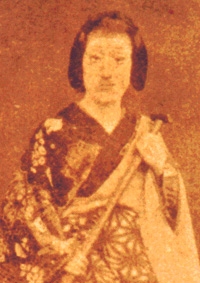 Stage name: Iwai Hanshirō VIII (assumed this name February 1872), Iwai Shijaku II 岩井紫若 (took this name in February 1864), Iwai Kumesaburō III 岩井粂三郎 (assumed this name in November 1832), Iwai Hisajirō II 岩井久次郎 (first appeared in children's roles using this name.)
Stage name: Iwai Hanshirō VIII (assumed this name February 1872), Iwai Shijaku II 岩井紫若 (took this name in February 1864), Iwai Kumesaburō III 岩井粂三郎 (assumed this name in November 1832), Iwai Hisajirō II 岩井久次郎 (first appeared in children's roles using this name.)Nickname: Shidō Hanshirō
Iwai Hanshirō VIII who was both tall and good-looking, was an excellent onnagata, especially in the sewamono roles, and considered as the worthy heir of his grand-father Iwai Tojaku. He costarred with the best tachiyaku from the last years of the Edo period to the first years of Meiji such as Ichikawa Danjûrō VIII, Kataoka Nizaemon VIII, Bandō Hikosaburō V, Ichikawa Kodanji IV, Nakamura Shikan IV, Onoe Kikugorō V and Ichikawa Danjûrō IX. He was one of the last true Edo onnagata.
He was born in Edo in the district of Sumiyoshi-chō and made his first stage appearance at an early age, playing children roles under the name of Iwai Hisajirō II. He took the name Iwai Hanshirô VIII in February 1872.
Iwai Komurasaki III 岩井小紫 (1851-1920)
Source: Kabuki 21 website http://www.kabuki21.com/komurasaki.php
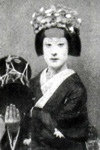 | Born in 1851. Disciple of Iwai Hanshirō VIII, he received the name of Iwai Komurasaki III. He was active in Tokyo from 1876 to the beginning of the 1890s. This lady-killer had a few tumultuous and scandalous love affairs, which have forced him to retire from the Kabuki world. He died in May 1920. |
Iwai Kumesaburō III (三代目)岩井粂三郎 (see Iwai Hanshirō VIII)
The actor Iwai Hanshirō VIII held this name from November 1832 to February 1864.
Iwai Shijaku II 岩井紫若 (see Iwai Hanshirô VIII)
The actor Iwai Hanshirô VIII took the name Iwai Shijaku II in February 1864 and held it until February 1872.
Iwai Shijaku IV 岩井紫若 (1854 - March 13, 1889)
Source: Kabuki 21 website http://www.kabuki21.com/shijaku.php
Born in Ôsaka in 1854. He started his career as a disciple of Jitsukawa Yaozô I, who gave him the name of Jitsukawa Yaoe. He went to Tôkyô in 1878 and was quickly adopted by Iwai Hanshirô VIII. He took the name of Iwai Shijaku III in July 1878 at the Miyakoza, playing in the drama "Koi no Yami Ame no Furudera". He was an onnagata actor, who was appreciated more in sewamono than in jidaimono. Just like the previous holder of the name, he died too young, at the age of 35, the 13th of March 1889.
Kataoka Gadō III 片岡 我童 (March 13, 1851 – April 16, 1895)
Source: Kabuki 21 website http://www.kabuki21.com/nizaemon10.php
Stage names: Kataoka Nizaemon X, Kataoka Gadō III, Kataoka Matsuwaka, Kataoka Tsuchinosuke I
Other name: Kataoka Roen III
Real name: Kataoka Tsuchinosuke
The actor Kataoka Nizaemon X held the name of Kataoka Gadō III from January 1872 to December 1894. Kataoka Nizaemon X was a talented actor able to perform a wide range of roles, as tachiyaku, katakiyaku or onnagata. His field of excellence was wagoto. He was endowed with a great voice and both his vocal projection and the way he delivered his lines were outstanding. He was not a stable man and his quarrels with his brother Kataoka Gatō III (who refused to take part in his shūmei) and the Kamigata star Ichikawa Udanji I drove him insane.
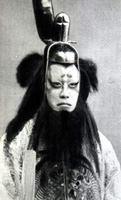 | Kataoka Ichizō III 片岡 市蔵 (27th day of the 4th lunar month of 1851 - 11 December 1906) Source: Kabuki 21 website http://www.kabuki21.com/kichizo3.php Stage names: Kataoka Ichizō III, Kataoka Chōjūrō II, Kataoka Gakusaburō I, Mimasu Kamezō Nickname: Kataichi Born in Osaka in the district of Sōemon-chō. He is the fourth son of Kataoka Shimamaru, son of Kataoka Nizaemon VII, who gave up acting to become a painter called Nishikawa Kuniharu (he was also called Kameya Kichibei or Sumidagawa Hikoroku). In the spring 1855 he starts his career as a disciple of the actor Mimasu Daigorō IV, who gives him the name of Mimasu Kamezō. In 1866, after an extended absence to take care of family matters, he goes back to the Kabuki world, becoming a disciple of the actor Kataoka Nizaemon VIII, thanks to the help of his second brother Kataoka Gatō II; he receives the name of Kataoka |
Kataoka Ichizō III was a katakiyaku actor of the Meiji era. He was better in sewamono than jidaimono. He became a great fukeyaku in his latter years. He also had the reputation to be extremely talented in literary arts.
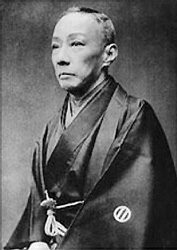 Source: By 不明 - http://www.kabuki-bito.jp/special/_actorofmemory_/post_133.html, パブリック・ドメイン, https://commons.wikimedia.org/w/index.php?curid=7859877 | Kataoka Nizaemon XI 片岡 仁左衛門 (1857 ~ October 16, 1934) Source: Kabuki 21 website http://www.kabuki21.com/nizaemon11.php Stage names: Kataoka Nizaemon XI, Kataoka Gatō III, Kataoka Hidetarō I Real name: Kataoka Hidetarō In January 1907 Kataoka Gatō III took the name of Kataoka Nizaemon XI at the Kadoza. Kataoka Nizaemon XI was a very popular and outstanding actor, who achieved fame for himself in both his native Kamigata and in Tōkyō. He was able to play a wide range of roles, as a tachiyaku or a katakiyaku or even an onnagata, in jidaimono as well as sewamono, in classics as well as Shinkabuki. Wagotoshi and jitsugotoshi roles were his forte. In Osaka, he and Nakamura Ganjirō I surpassed themselves for the title of best wagotoshi. In Tōkyō, his main stage partners were Ichimura Uzaemon XV and Nakamura Utaemon V. This threesome was nicknamed San'emon ("The Three Emon") and their performances were extremely successful. |
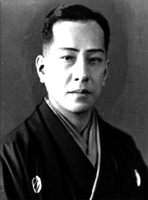 wikipedia | Kataoka Nizaemon XII 片岡 仁左衛門 (9 September 1882 ~ 16 March 1946) Source: Kabuki 21 website http://www.kabuki21.com/nizaemon12.php Stage names: Kataoka Nizaemon XII, Kataoka Gadō IV, Kataoka Tsuchinosuke II, Kataoka Tōkichi Other name: Kataoka Roen IV,Kataoka Gadō XII Real name: Kataoka Tōkichi In January 1896 Kataoka Tōkichi takes the name of Kataoka Tsuchinosuke II at the Kabukiza. In March 1901 Kataoka Tsuchinosuke II takes the name of Kataoka Gadō IV in Osaka at the Kadoza. In January 1936 Kataoka Gadō IV takes the name of Kataoka Nizaemon XII at the Kabukiza. On March 16 1946 "his life and career were cut short when ... he and four others in his household were murdered by Toshiaki Iida, in the actor's home. Iida was a writer who had been living in a detached house on the actor's property. Like the |
Kataoka Nizaemon XII was the first in this prestigious line of actor to focus on onnagata roles. After the death of Onoe Baikō VI in 1934, he became the main stage partner in female roles of the star Ichimura Uzaemon XV. He was extremely popular in Tokyo as well as Osaka.
Kataoka Tsuchinosuke II 片岡土之助 (see Kataoka Nizaemon XII)
The actor Kataoka Nizaemon XII held the name Kataoka Tsuchinosuke II from January 1896 to March 1901.
Kawarazaki Gonjūrō I 河原崎権十郎 (see Ichikawa Danjūrō IX)
Kawarazaki Kunitarō I 河原崎国太郎 (1849-1867)
Born in Edo in 1849. Son of Kawarazaki Gonnosuke VI, he started his career as a wakashugata (actors specializing in adolescent male roles )in the 2nd lunar month of 1859, at the Ichimuraza where he received the name of Kawarazaki Kunitarō I. He became wakaonnagata (onnagata specialized in young maiden or princess roles) in the 11th lunar month of 1863, playing the role of Okumi in the drama "Kanadehon Chûshingura". He made his last stage apperance in the 2nd lunar month of 1867, at the Ichimuraza, playing the roles of the courtesan Kewaizaka no Shōshō and Ohaya in the drama "Keisei Soga Kuruwa Kagami". He died in Edo the 21st of 4th lunar month of 1867.
Kawarazaki Sanshō 河原 崎三舛 (see Ichikawa Danjûrō IX)
Source: Kabuki 21 website http://www.kabuki21.com/danjuro9.php
Ichikawa Danjûrō IX took the name Kawarazaki Sanshō in September 1873.
Real name: Sobue Yoshisaburō
Nakamura Fukusuke I (初代)中村福助 (see Nakamura Shikan IV)
Nakamura Shikan IV held this name from March 1839 until July 1860.
Nakamura Fukusuke IV (Narikomaya) 中村 福助 (see Nakamura Utaemon V)
Source: Kabuki 21 website http://www.kabuki21.com/fukusuke.php
The actor Nakamura Utaemon V held the name of Nakamura Fukusuke IV from May 1881 to April 1901. He made his first stage appearance in August 1876 and became one of the best onnagata actors of the first half of the twentieth century.
Nakamura Ganpachi 中村鴈八 (see Nakamura Tsuruzō II)
Nakamura Kanjaku III 中村 翫雀 (1841 ~ 3 February 1881)
Source: Kabuki 21 website http://www.kabuki21.com/kanjaku3.php
Born in Ôsaka in 1841, his father is a policeman. He joins a troupe of children-actors (kodomo shibai) at the age of 11, playing under the name of Arashi Kakuzô I.
Nakamura Kanjaku III was a talented Kamigata actor, who was able to play tachiyaku or onnagata roles and was equally at home in sewamono and jidaimono dramas. Wagotoshi or toshima roles were his forte.
Nakamura Kichiemon 中村 吉右衛門 (24 March 1886 ~ 5 September 1954)
Source: Kabuki 21 website http://www.kabuki21.com/kichiemon1.php
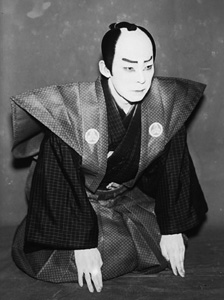 as Takebe Genzō, in Sugawara Denju Tenarai Kagami Japan Arts Council | Real name: Namino Tatsujirō Poetry name: Shūzan Born in 1986 in the Asakusa district of Tokyo, his mother was the daughter of a shibai jaya owner named Yorozuya Kichiemon. In 1897, he makes his first stage appearance, at the Asakusaza, where he receives the name of Nakamura Kichiemon I and quickly becomes the zagashira of a troupe of children-actors (kodomo shibai). In 1943, Kichiemon sets up his own troupe, the Kichiemon Gekidan (literally "Kichiemon's theatrical troupe"). In 1951, Kichiemon publishes his autobiography titled "Kichiemon Jiden" (literally "Kichiemon's autobiography"). In November 1952, Kichiemon plays for the last time the role of Shunkan in the drama "Heike Nyogo-ga-Shima", which is staged at the Kabukiza. His stage partners are Nakamura Utaemon VI (Chidori) and Nakamura Tokizō III (Tanzaemon). In July 1954, Kichiemon appears on stage for the last time, at the Kabukiza, playing the role of Kumagai Jirō Naozane in "Kumagai Jin'ya". Nakamura Kichiemon I was one of the best tachiyaku actors of the |
Nakamura Kichiemon I's best roles: Shunkan ("Shunkan"), Kōchiyama Sōshun ("Kōchiyama"), Takebe Genzō ("Terakoya"), Ichijō Ōkura ("Ichijō Ōkura Monogatari"), Banzui Chōbei ("Yudono no Chōbei"), Jirōzaemon ("Kagotsurube Sato no Eizame"), Takechi Mitsuhide ("Badarai no Mitsuhide"), Matsuura Shizunobu ("Matsuura no Taiko"), Benkei ("Kanjinchō"), Sasaki Moritsuna ("Moritsuna Jinya"), Kumagai Jirō Naozane ("Kumagai Jin'ya"), Yatagorō Genshichi ("Kamiyui Shinza"), Daihanji no Kiyosumi ("Imoseyama Onna Teikin"), Kiuchi Sōgo ("Sakura Giminden") and Ōboshi Yuranosuke ("Kanadehon Chūshingura").
Nakamura Kichiemon I was particularly interested in the warrior Katō Kiyomasa and many new dramas were written especially for him in this role. He gathered them and others dramas in a special collection of six plays called Shūzan Jisshu, which includes "Nijōjō no Kiyomasa", "Urusanjō no Kiyomasa", "Kumamotojō no Kiyomasa", "Matsuura no Taiko", "Yasaku no Kamabara" and "Kiyomasa Seichūroku".
"Nakamura Kichiemon, a member of the Kabukiza company, is a meteor-like actor, having risen rapidly and by sheer ability, for he has little ancestral prestige to enhance his reputation. He has no pretensions to boast of as a dancer, but in the loyalty characters of the Kabuki masterpieces, in creating afresh the roles left by Chikamatsu Monzaemon I, Takeda Izumo, and Chikamatsu Hanji, he is unsurpassed." (written in 1925, when Kichiemon was at the end of his thirties, by Zoë Kincaid in "Kabuki, the Popular Stage of Japan")
Nakamura Nakazô III (三代目) 中村仲蔵 (1809 - 24 December 1886)
Source: Kabuki 21 website http://www.kabuki21.com/nakazo3.php
Stage names: Nakamura Nakazô III and Nakamura Tsuruzô I
Other name: Nakamura Kanzaburô XIV
Nakamura Nakazô III was an outstanding supporting actor, excelling in katakiyaku and fukeyaku roles. He was also an excellent dancer. He transmitted his amazing knowledge of Kabuki to the rising stars Onoe Kikugorô V and Ichikawa Danjûrô IX. His most notable role was Kômori Yasu in Segawa Jokô III's drama Yowa Nasake Ukina no Yokogushi.
Nakamura Shikan IV 中村芝翫 (3 March 1831 ~ 16 January 1899)
Source: Kabuki 21 website http://www.kabuki21.com/shikan4.php
Stage names: Nakamura Shikan IV, Nakamura Fukusuke I, Nakamura Komasaburô, Nakamura Tamatarô I
He starts his career at an early age and plays under the names of Nakamura Tamatarô I and Nakamura Komasaburô. In 1838, he is adopted by Nakamura Utaemon IV and in March 1839 he takes the name of Nakamura Fukusuke I at the Nakamuraza. In July 1860, he takes the name of Nakamura Shikan IV at the Nakamuraza,
Nakamura Shikan IV was a great Meiji actor, who achieved fame for himself all over Japan (he toured a lot). He was equally at home in sewamono and jidaimono dramas, able to play almost any kind of role as tachiyaku, katakiyaku or even onnagata. He created many kata and some of them are still sometimes revived, like the ones for the role of Kumagai Jirô Naozane in the "Kumagai Jin'ya" scene of the classic "Ichi-no-Tani Futaba Gunki".
His rivalry with Bandô Hikosaburô Vwas one of the hottest in Kabuki history: "So nearly matched in abilitywere Shikan and Hikosaburô, with but two years' difference in theirages, that they were pitted against each other, and their patrons oftenindulged in fights over them. During a performance, when these actorswere playing together, they came through the audience by way of the twohanamichi, the one to the right of the stage a mere footpath, that to the left a platform that was in reality a continuation of the stage proper. They quarrelled as to who should take the main hanamichi, and the dispute waxed so hot that they finally drew lots to settle the matter." (Zoë Kincaid in Kabuki, the Popular Stage of Japan)
Nakamura Shikan V 中村芝翫 (see Nakamura Utaemon V)Nakamura Fukusuke IV (Nakamura Utaemon V) took the name of Nakamura Shikan Vin May 1901.
Nakamura Sôjûrô 中村宗十郎 (1835 ~ 8 October 1889)
Source: Kabuki 21 website http://www.kabuki21.com/nsojuro2.php
Stage names: Nakamura Sôjûrô, Mimasu Gennosuke III, Nakamura Kamezô, Arashi Kamezô
Real name: Fujii Jubei
Nakamura Sôjûrô was an outstanding and very popular wagotoshi, competing with Jitsukawa Enjaku I for the title of best Kamigata tachiyaku. It is said that Nakamura Sôjûrô and Jitsukawa Enjaku I were the equivalent in Ôsaka of Ichikawa Danjûrô IX and Onoe Kikugorô V in Edo. Nakamura Sôjûrô also acted in a wider range of roles, from katakiyaku to onnagata (for example the difficult role of Sodehagi in "Ôshû Adachi-ga-Hara"). He was opposed to the Meiji theater reforms and temporarily left the stage to open a dry goods business. Fans' pressure was so strong that he quickly returned to the stage.
 | Nakamura Tôzô V 中村東蔵 (see Ôtani Tomoemon VI) Source: Kabuki 21 website http://www.kabuki21.com/ntozo.php The actor Ôtani Tomoemon VI held the name of Nakamura Tôzô V from November 1911 to March 1920. |
Nakamura Tsuruzō I 中村鶴蔵 (see Nakamura Nakazô III)
Nakamura Utaemon V 中村歌右衛門 (29 December 1865 ~ 12 September 1940)
Source: Kabuki 21 website http://www.kabuki21.com/utaemon5.php
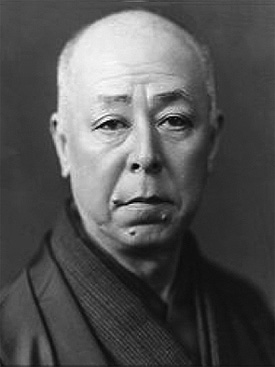 Utaemon Nakamura V (1866–1940) Utaemon Nakamura V (1866–1940)wikipedia undated photo | Stage names: Nakamura Utaemon V, Nakamura Shikan V, Nakamura Fukusuke IV, Nakamura Kotarô I Nakamura Utaemon V was one of the best onnagata actors of the first half of the twentieth century. He was the first in this prestigious line of actors to focus on female roles but kept on performing important male roles belonging to the line, like the king of thieves Ishikawa Goemon ("Sanmon"). One of his best roles was Lady Yodo (Yodogimi) in several Shinkabuki dramas written for him. He gathered them from 1921 in a special collection of plays, which was called Yodogimishû and included "Kiri Hitoha", "Hototogisu Kojô no Rakugetsu", "Yodogimi", "Daigo no Haru", "Ôsakajô" or "Yodogimi Odawara Jin". His others best roles are Princess Yaegaki ("Jusshukô"), Princess Toki ("Kamakura Sandaiki"), Masaoka ("Meiboku Sendai Hagi"), Agemaki ("Sukeroku") and Tonase ("Kanadehon Chûshingura"). In his latter years, he terribly suffered because of lead poisoning. |
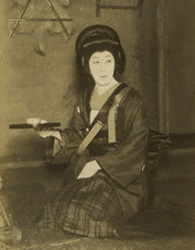 Otowaya Onoe Kikugoro/Kikunosuke Official Home Page | Onoe Baikō VI 尾上梅幸 (October 1870 - November 1934) Source: Kabuki 21 website http://www.kabuki21.com/baiko6.php Stage names: Onoe Baikō VI 尾上梅幸, Onoe Eizaburō V 尾上栄三郎, Onoe Einosuke I Other name: Nishikawa Einosuke Real name: Terashima Einosuke Born in Nagoya in 1870, at the age of six he becomes a disciple of the Buyō Master Nishikawa Koisaburō, receiving the name of Nishikawa Einosuke. In 1882 the young Einosuke is adopted by Onoe Kikugorō V. In January 1885 he takes the name of Onoe Einosuke I and appears on stage for the first time. In May 1891 Onoe Einosuke I takes the name of Onoe Eizaburō V at the Shintomiza (Tokyo) and in March 1903 he takes the name of Onoe Baikō VI. He announced that he would be retiring after giving a final performance at a memorial ceremony to be held in honour of Kikugoro V in 1935, but he collapsed on stage at the Kabuki-za and died unexpectedly in November 1934.1 |
1 Otowaya Onoe Kikugoro/Kikunosuke Official Home Page "Onoe Baiko VI - A Beautiful Onnagata Active Through the Meiji, Taisho and Showa Eras"
Onoe Einosuke I 尾上栄之助( おのえ えいのすけ)(see Onoe Baikō VI)
Onoe Kikugorō IV (四代目) 尾上菊五郎 (1808 ~ 1860)
Stage names: Onoe Kikugorô IV, Onoe Baikô IV, Onoe Eizaburô III, Onoe Kikushi, Nakamura Tatsuzô, Nakamura Kachô
Others names: Baikô Kikugorô
Father-in-law and adoptive father: Ôkawa Hashizô I (Onoe Kikugorô III)
Onoe Kikugorô IV was the only actor in this prestigious lineage to play mainly onnagata roles. His best role was the menoto Masaoka in the classic "Meiboku Sendai Hagi".
 Onoe Kikugorō V as Kamiyui Shinza, in the play "Tsuyu Kosode Mukashi Hachijō". | Onoe Kikugorô V (五代目) 尾上菊五郎 (4 June 1844 ~ 18 February 1903) Source: Kabuki 21 website http://www.kabuki21.com/kikugoro5.php Stage names: Onoe Kikugorô V, Ichimura Kakitsu IV, Ichimura Uzaemon XIII, Ichimura Kurôemon Others names: Onoe Baikô V, Onoe Kurôemon I Onoe Kikugorô V belonged to the triumvirate of stars who dominatedthe Kabuki world during the Meiji era (the two others were IchikawaDanjûrô IX and Ichikawa Sadanji I). He created with Kawatake Mokuami anew genre called zangirimono. "He succeeded to the headship of the Onoe family, ranked with the ninthDanjûrô, and in some respects surpassed him. It was in drama ofeveryday life that Kikugorô most excelled, the sentimental andrealistic having the greatest appeal for him." (Zoë Kincaid in "Kabuki,the Popular Stage of Japan") |
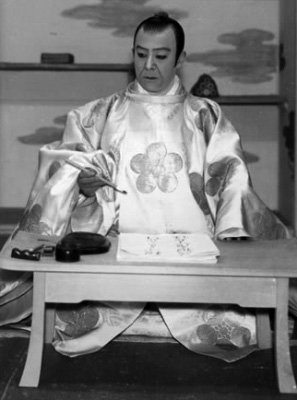
Source: Kabuki 21 website http://www.kabuki21.com/kikujiro2.php
Stage names: Onoe Baika, Onoe Kikujirô II, Nakamura Sankô II, Nakamura Karyû, Kataoka Ichimatsu
Onoe Kikujirô II was a talented wakaonnagata, excelling in the roles of housewives in sewamono dramas. He co-starred with stage giants like Ichikawa Danjûrô VIII, Ichikawa Kodanji IV and Ichikawa Danjûrô IX.
Onoe Kikujirō III 三代目尾上菊次郎 (October 10, 1882 - August 27, 1919)
Source: Kabuki 21 website http://www.kabuki21.com/kikujiro3.php
| Onoe Fujaku VIII (Onoe Kikujirō III) playing the role of Princess Minazuru in the drama "Kikubatake" (end of the 1900s) | Stage names: Onoe Kikujirō III, Onoe Fujaku VIII 八代目尾上芙雀, Onoe Umejirō 尾上梅次郎 Real name: Okada Kōjirō Poetry name: Baika Born into a publishing family in Tokyo's Kōjimachi district, he became a disciple of Onoe Kikugorō V in May 1983 and appears on stage for the first time at the Harukiza (Tokyo), where he receives the name of Onoe Umejirō. In May 1905, he becomes nadai and takes the name of Onoe Fujaku VIII. In March 1915, he takes the name of Onoe Kikujirō III, playing the prestigious role of the courtesan Agemaki in the drama "Sukeroku no Momoyogusa". In August 1919, Kikujirō appears on stage for the last time, at the Imperial Theater, playing the roles of Otsuyu's ghost and Omine in the summer ghost play "Kaidan Botan Dōrō". He suddenly dies on August 27. Onoe Kikujirō III was a talented onnagata. Unfortunately he died young at the age of 38. His best role was the courtesan Michitose in the drama "Naozamurai". |
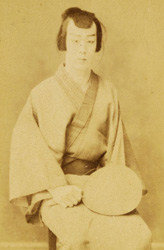 The British Museum 2001,0215,0.1.1-42 | Onoe Kikunosuke II 尾上菊之助 (1868 ~ 28 June 1897) Source: Kabuki 21 website http://www.kabuki21.com/kikunosuke2.php Stage names: Onoe Kikunosuke II, Onoe Shôkô Real name: Terashima Hidesaku In 1870 he is adopted by Onoe Kikugorō V. In 1886 he quarrels with his adoptive father and in February 1887 he takes the name of Onoe Shōkō in Osaka, where he tries to give a boost to his career. In January 1891 he goes back to Tokyo, where he becomes reconciled with his adoptive father Onoe Kikugorō V. He takes back the name of Onoe Kikunosuke II. Onoe Kikunosuke II was a promising actor of the Otowaya guild, who unfortunately died at the age of 29. His life was dramatized in the novel "Zangiku Monogatari" (literally "Late Chrysanthemums"). In this story written by Muramatsu Shōfû, Kikunosuke was openly praised for his stage performances, only because he was his father's heir. Otoku, the wet-nurse of his brother, was the only one to be sincere enough to tell Kikunosuke the truth about his performances but she also had faith in his talent. Kikunosuke fell in love with |
Onoe Kikusaburō V 尾上 菊三郎 (no information available)
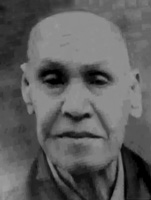 | Stage names: Onoe Matsusuke IV, Onoe Umegorō, Ichimura Kitsugorō Matsumoto Kokanshi Real name: Kurihara Umegorō Connections: Masters: Onoe Kikugorō V, Matsumoto Kinshō The actor Onoe Matsusuke IV held this name from June 1881 to September 1928. Born in Osaka in the district of Shimanouchi, his father Kurihara Yasuke was a backstage assistant of the Edo star Matsumoto Kōshirō V. Comments: Onoe Matsusuke IV was a talented supporting tachiyaku, excelling in fukeyaku or katakiyaku roles in sewamono dramas. |
Source: Kabuki 21 website http://www.kabuki21.com/taganojo2.php
Stage names: Onoe Taganojô II, Onoe Kikumatsu I
Real name: Onoe Kikumatsu
Onoe Taganojô II was a good onnagata actor of the Meiji era. His forte were spouse roles in jidaimono
drama. He last appears on the Tokyo stage in May 1894 becoming a traveling actor and then passing away suddenly on the 26th of June 1899 in the city of Kanazawa.
Ôtani Tomoemon V 大谷友右衛門 (1833 ~ 1 February 1873)
Source: Kabuki 21 website http://www.kabuki21.com/hiroji5.php
Ôtani Tomoemon V was the stage name of Ôtani Hiroji V from 1865 to August 1869, then a second time from April 1871 to February 1873. He was an overweight actor, able to play tachiyaku, katakiyaku, oyajigata or onnagata, in both jidaimono and sewamono.
Ôtani Tomoemon VI 大谷友右衛門 (June 1886 ~ 1 September 1943)
Source: Kabuki 21 website http://www.kabuki21.com/tomoemon6.php
Stage names: Ôtani Tomoemon VI, Nakamura Tôzô V, Nakamura Komasuke, Nakamura Omocha, Nakamura Kanbei
Real name: Aoki Yaetarô
Ôtani Tomoemon VI was a talented and popular supporting tachiyaku, specialized in katakiyaku and oyajigata roles. He was a stage partner for the stars Onoe Kikugorô VI and Ichikawa Ennosuke II.
Source: http://www.kabuki21.com/gennosuke4.php
Stage names: Sawamura Gennosuke IV, Sawamura Seijûrô II, Sawamura Seizaburô, Sawamura Seishi II
Real name: Sawamura Seizaburô
Sawamura Gennosuke IV was an outstanding onnagata actor, who was also able to play a wide range of male roles. Akuba roles were his field of excellence, like Otomi ("Kirare Otomi") or Dakki no Ohyaku ("Hyaku Monogatari"). He moved at the beginning of the 20th century from ôshibai, where he was supporting the stars Ichikawa Danjûrô IX and Onoe Kikugorô V, to koshibai, performing as a leading actor in venues like the Asakusaza or the Miyatoza. He joined back the ôshibai in his latter years. He was considered as the last true Edo onnagata.
Sawamura Hyakunosuke 沢村 百之助 (1857 ~ 3 April 1899)
Source: Kabuki 21 website
Stage names: Sawamura Tanosuke IV 沢村 田之助 (took this name in January 1881 after the death of his adoptive father.)
Sawamura Tanosuke IV was a good onnagata of the Meiji era.
Source: Kabuki 21 website http://www.kabuki21.com/sojuro7.php
Stage names: Sawamura Sōjūrō VII, Sawamura Tosshō III, Sawamura Gempei IV
Real name: Sawamura Fukuzō
Poetry name: Kōga
Crest: the syllabic ideogram "i" in a circle [in Japanese: い]
Born in 1875 in the Tsukiji district of Tokyo, he may have been the son of a priest based in the Honganji temple in Tsukiji. In 1881 he was adopted by Suketakaya Takasuke IV, who gives him the civil name of Sawamura Fukuzō. In November 1881 he makes his first stage appearance at the Hisamatsu-za, where he receives the name of Sawamura Gempei IV. In 1892, Sawamura Gempei IV take the name of Sawamura Tosshō III at the Nakaza (Osaka). In September 1908, Sawamura Tosshō III takes the name of Sawamura Sōjūrō VII. On March 2, Sōjūrō collapses on a Himeji theater's stage while playing the role of Kampei in the drama "Kanadehon Chūshingura".
Sawamura Sōjūrō VII was an amazing onnagata and wagotoshi, a talented dancer, who led with Onoe Kikugorō VI, Matsumoto Kōshirō VII and Ichimura Uzaemon XV the Kabuki world from the end of the Meiji era to the end of the forties.
His special methods of acting gave birth to the expression " Sōjūrō Kabuki".
Sawamura Sōjūrō VII gathered his 10 best roles in a collection called kôga jisshu. The most famous ones are Ofune ("Shinrei Yaguchi no Watashi"), Yaegiri ("Komochi Yamamba"), Fukuoka mitsugi ("Ise Ondo"), Dôshin ("Karukaya Dōshin Tsukushi no Iezuto") and Ranchō ("Wakaki Uchina Gusa"). Others famous roles of Sawamura Sōjūrō VII were Fujiya Izaemon ("Kuruwa Bunshō"), Bimyô ("Moritsuna Jinya") and Kakuju ("Sugawara Denju Tenarai Kagami").
"The seventh Sawamura Sōjūrō is also one of the Imperial Theatre stars. He acts so well with Baikō and Kōshirō that they form a perfect trio, and when there is a break in this stage comradeship, Tokyo will be conscious of a blank like that which was experienced when the three great actors of Meiji passed away one after the other. Sōjūrō is at his best in samurai and aristocratic roles, He also makes a fascinating woman, and his ability in the dance, while not so striking as that of Baikō and Kōshirō, is still very great." (Zoë Kincaid in "Kabuki, the Popular Stage of Japan")
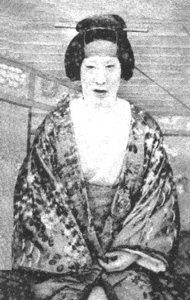 『伽羅先代萩』の乳母政岡(推定) | Sawamura Tanosuke III 沢村(澤村) 田之助 (8 February 1845 ~ 7 July 1878) Source: Kabuki 21 website http://www.kabuki21.com/tanosuke3.php Stage names: Sawamura Shozan III, Sawamura Tanosuke III, Sawamura Yoshijirō I The second son of Sawamura Sōjūrō V, he was a first rate actor. In the first year of Meiji (1867), he was playing at the three chief theatres in Saruwaka-chō. At the age of 16, he began to act in leading onnagata roles, and was a genius in the delineation of women's characters. A tragic fate overtook him, and his loss to the Tôkyô stage was very great. Suffering an injury to his feet, gangrene set in. Everything was done to save him, and he was taken to Yokohama, where an American medical missionary was consulted. Both feet, however, were amputated in 1869. In spite of this great physical disability, Tanosuke continued to appear on the stage, supported by several black-robed property-men, and so great was his popularity that the people crowded to see him. His wife was unfaithful to him, and was on intimate terms with one of his pupils, and this added to his hopeless condition, filling the remaining days of this unfortunate onnagata star with unhappiness. |
Sawamura Tosshi VI 沢村訥子 (さわむら とっし)(see Sawamura Tosshō II)
Source: Kabuki 21 website http://www.kabuki21.com/takasuke4.php
Stage names: Suketakaya Takasuke IV, Sawamura Tosshō II, Sawamura Gempei II
Others names: Sawamura Sōjūrō VI, Sawamura Tosshi VI
Sawamura Tosshō II was a stage name for Suketakaya Takasuke IV. He was the worthy heir of his father Sawamura Sōjūrō V, excelling in wagotoshi, wajitsu or onnagata roles. He shared the stage with the Meiji giants Ichikawa Danjūrō IX and Onoe Kikugorō V. He posthumously received the name of Sawamura Sōjūrō VI.
Sawamura Tosshō III 沢村 訥升 (See Sawamura Sōjūrō VII )
The actor Sawamura Sōjūrō VII held the name of Sawamura Tosshō III from January 1893 to August 1908.
Suketakaya [Sukedakaya] Takasuke IV 助高屋 高助 (see Sawamura Tosshō II)
Takasagoya* Fukusuke III 高砂屋 福助 (Nakamura Fukusuke III 中村 福助) (28 December 1841 ~ 8 June 1921)
* identifying the Takasagoya actor guild
Source: Kabuki 21 website http://www.kabuki21.com/fukusuke.php
Stage names: Nakamura Baigyoku II, Nakamura Fukusuke III, Mimasu Tanin V, Nakamura Tamazô, Fujioka Kikutarô
Real name: Sasaki Norikazu
The actor Nakamura Baigyoku II held the name of Nakamura Fukusuke III from March 1868 to September 1907. He was a kaneru yakusha, excelling in both jidaimono and sewamono. He co-played a lot with the Kamigata stars Jitsukawa Enjaku I and Nakamura Ganjirô I.
